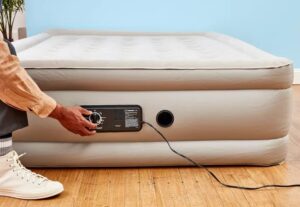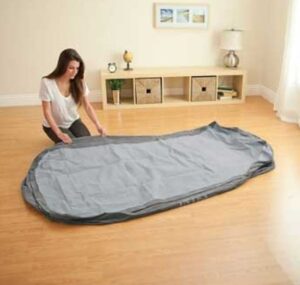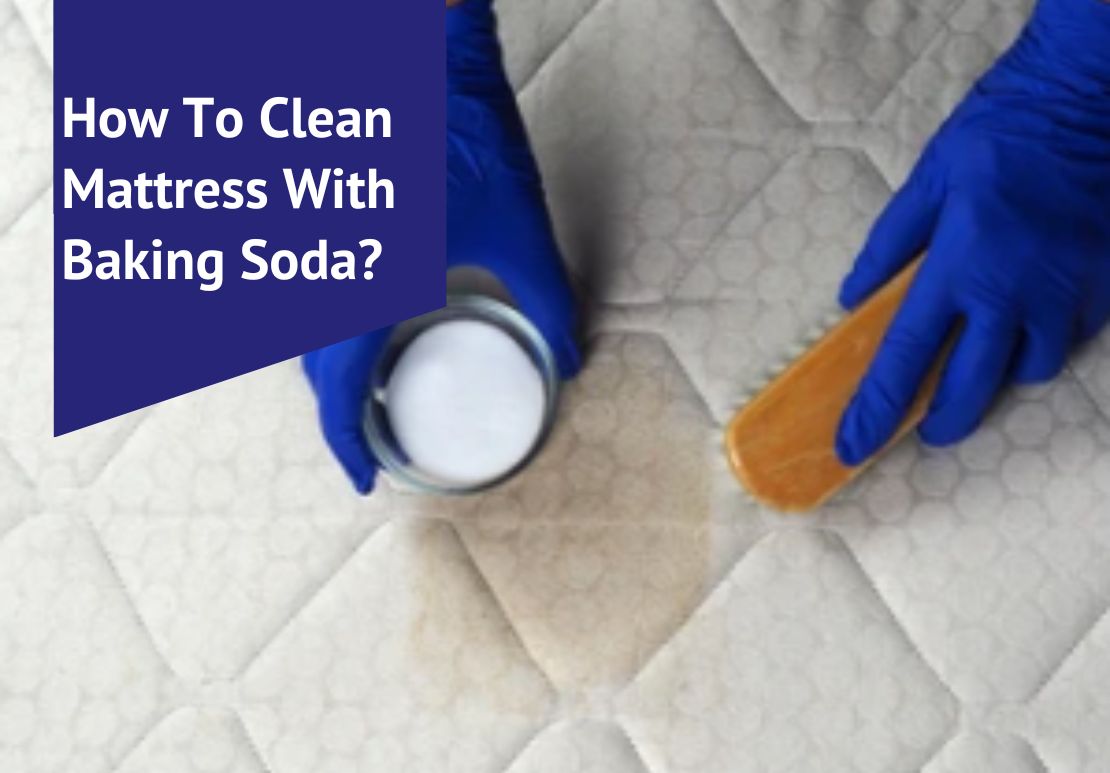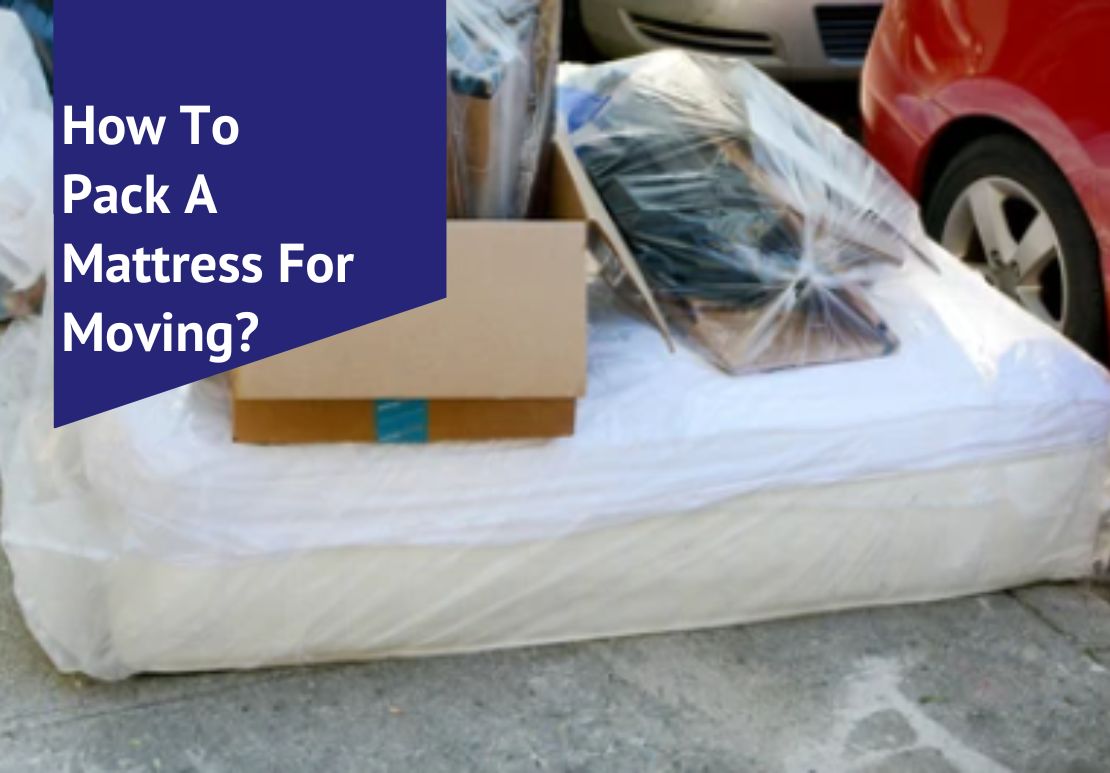Finding your air mattress deflated after a night’s rest can leave you puzzled and, quite frankly, with an achy back. Despite careful use, these inflatable beds are notorious for losing air.
This article will explore the myriad reasons behind this common problem and offer actionable advice to keep your mattress firm all night long. Keep reading to ensure your sleep isn’t full of surprises.
Table of Contents
Key Takeaways
- Air mattresses deflate because of factors like improper use, temperature changes, leaks or holes, and issues with the pump. Avoid jumping on the mattress or sitting on its edges to prevent strains leading to punctures or weakened seams.
- Regularly inspect your air mattress for damage, such as micro-tears, especially when vinyl becomes more brittle in cold temperatures. Use a patch kit designed for inflatable beds to fix any leaks.
- To keep your air mattress from deflating overnight, partially underfill it if you expect temperatures to drop. This gives room for contraction and helps maintain comfort.
- Store your air mattress by folding it gently without sharp bends, and keep it in a cool, dry place out of direct sunlight. Follow manufacturer weight guidelines, and don’t overinflate the bed to reduce stress on materials.
- If deflation problems persist despite proper care and maintenance or if there are visible signs of significant wear like sagging, frequent deflation, or noticeable punctures, consider replacing your air mattress.
Reasons Why Air Mattresses Deflate
Air mattresses may deflate due to improper use, temperature changes, pumping issues, or holes and leaks. These factors can lead to a loss of air pressure and result in a sagging sleeping surface.
Improper use
Using your air mattress in ways it’s not intended can lead to unwanted deflation. Jumping or bouncing on it can strain the seams and weaken the material, making it more prone to leaks.
Sitting at the edges for prolonged periods may stretch and damage its structure beyond repair. Keeping pets away from your sleeping pad is crucial, as their claws can easily puncture the vinyl surface, leading to a slow leak that’s difficult to spot until you find yourself on a sagging mattress.
Sticking to usage instructions isn’t just about maintaining air retention and ensuring longevity. Exceeding weight limits puts extra pressure on every part of your inflatable bed, risking seam leaks over time that could render your mattress unusable.
Careful use means avoiding rough treatment like dragging across rough surfaces or storing without proper folding, which could introduce tears or holes, gradually reducing the effectiveness of your air pump and repair kit efforts.
Temperature
Moving from the risks of improper use, it’s crucial to consider how temperature plays a role in air mattress deflation. Temperature changes can wreak havoc on your inflatable mattress because the air inside expands and contracts with heat and cold.
If you’ve ever woken up feeling closer to the ground than when you went to sleep, it might be due to a drop in room temperature, causing the air pressure inside your mattress to decrease.
Keep an eye on your thermostat settings or consider the natural temperature fluctuations if you’re camping outdoors. Vinyl, often used in air mattresses, becomes more rigid when cold, increasing its vulnerability to developing micro-tears that lead to slow leaks over time.
To maintain optimal air retention during colder nights, slightly underfill your sleeping pad at bedtime; this allows some room for contraction without putting too much stress on seams and material.
During hotter periods, avoid direct sunlight exposure as extreme heat can also cause expansion, leading to potential seam leaks or overall degradation of the vinyl material faster than expected.

Pumping issues
Problems with the air pump can lead to your air mattress deflating. If the pump isn’t working efficiently, it might not fully inflate the mattress, creating a saggy and uncomfortable surface that appears to lose air faster.
Check that your pump is in good condition and provides a tight seal during inflation. An inadequate seal can cause slow leaks, which may not be immediately noticeable but result in significant overnight deflation.
Ensuring an effective pumping strategy is crucial for maintaining optimal air retention. Use pumps specifically designed for your air mattress model to avoid compatibility issues that could impair proper inflation.
Some mattresses come with built-in pumps; for these models, periodically test the mechanism to ensure its effectiveness, as wear and tear over time can reduce functionality, contributing to gradually losing firmness as you sleep.

Holes/leaks
When it comes to air mattresses, holes and leaks are common culprits for deflation. Over time, the material of the mattress can develop tears or punctures due to various factors such as sharp objects, pet claws, or even normal wear and tear.
These holes and leaks can cause the air to escape gradually, resulting in a deflated mattress each morning. It is crucial for homeowners to regularly inspect their air mattresses for any signs of damage and promptly address any found holes or leaks using a repair kit specifically designed for inflatable mattresses.
Tips to Increase the Lifespan of an Air Mattress
Fold your air mattress with care, monitor room temperature, lay it flat when not in use, and avoid excessive weight to ensure a longer lifespan. For more tips on maintaining your air mattress, keep reading!
Fold with care
Careful folding is crucial for preserving the longevity of your air mattress. When not in use, fold it gently and avoid any sharp bends or creases that could damage the material. Proper folding prevents unnecessary stress on seams and reduces the risk of developing tears or leaks over time.
Homeowners should fold their air mattresses neatly and store them in a cool, dry place away from direct sunlight. By taking these precautions, you can significantly prolong the lifespan of your air mattress and ensure a comfortable sleep every night.
Monitor room temperature
To prolong the lifespan of your air mattress, it’s important to monitor room temperature. Fluctuations in temperature can affect the air pressure inside the mattress, leading to deflation over time.
Extreme heat or cold can cause the air inside the mattress to expand or contract, ultimately affecting its firmness and leading to potential leaks or tears. Maintaining a consistent room temperature can prevent unnecessary stress on the material and ensure that your air mattress retains its firmness for longer.
It’s crucial to remember that sudden changes in room temperature can impact the overall performance of your air mattress.
Lay flat
To ensure the longevity of your air mattress, laying it flat when not in use is essential. Improper storage, such as leaving the mattress folded or stored on its side, can lead to material stress and potential damage.
Laying your air mattress flat when not in use minimizes the risk of creases and folds that could compromise its structural integrity over time.
Additionally, laying the air mattress flat helps distribute weight evenly across its surface. This reduces strain on specific areas of the mattress and minimizes the risk of developing weak spots or tears.
Avoid excessive weight
To prevent air mattress deflation, homeowners should avoid placing excessive weight on the mattress. Overburdening the airbed with more weight than its intended capacity can lead to increased pressure on the seams and material, causing them to weaken and potentially develop leaks over time.
Adhering to the weight limit specified by the manufacturer is crucial in maintaining the integrity of the air mattress and preventing premature deflation. Additionally, avoiding activities that subject the mattress to unnecessary strain, such as jumping or rough play, can help preserve its structural durability.
Furthermore, regularly inspecting for any signs of wear and tear due to excess weight is essential for identifying potential issues before they escalate. By being mindful of weight limitations and taking proactive measures to prevent overloading, homeowners can significantly prolong the lifespan of their air mattresses while minimizing the risk of deflation.
Understanding these fundamental principles will enable homeowners to make informed decisions about caring for their air mattresses.
Identifying the Cause of Your Deflating Air Mattress
To identify the cause of your deflating air mattress, verify the problem and pinpoint the leak. Once you’ve located the source, clean the area thoroughly and patch the leak using a repair kit for inflatable mattresses.
Verify the problem
To determine why your air mattress is deflating, check for visible signs of damage, such as punctures or tears. Inspect the entire surface and especially pay attention to seams and corners where leaks are more likely to occur.
Use soapy water in a spray bottle or sponge to pinpoint the source of any small air bubbles that indicate a leak. Once you identify the problem area, thoroughly clean it before applying a patch using a vinyl repair kit designed for air mattresses.
Ensuring proper inflation and regular maintenance can prevent potential issues with your air mattress. Keep in mind that even a well-cared-for mattress may still develop leaks over time due to wear and tear, temperature changes, or exceeding weight limits.
Pinpoint the leak
Inspect the mattress carefully for any visible tears, punctures, or holes. Use a soapy water solution in areas where leaks are suspected. Look for bubbles that indicate the location of the leak.
Once identified, thoroughly clean and dry the area before applying a patch using a vinyl repair kit. Ensure that the patch is securely applied to prevent further air loss.
Regular inspection is crucial in maintaining the integrity of your air mattress. By promptly addressing leaks, you can prolong its lifespan and enjoy a restful night’s sleep without interruptions due to deflation issues.
Clean the area
Inspect the area around your air mattress for any debris, sharp objects, or potential puncture hazards. Use a damp cloth to wipe down the surface and check for any signs of wear and tear on the material.
This will help ensure that it’s easier to access and repair when you locate the leak in your deflating air mattress. Remember that maintaining a clean sleeping environment extends your air mattress’s lifespan and promotes better sleep quality.
Patch the leak
To patch the leak in your air mattress, verify the problem area. Once you pinpoint the source of the leak, thoroughly clean and dry the affected spot. Next, carefully apply a vinyl repair patch or adhesive from a repair kit to seal the hole effectively.
By following these steps and using proper materials, you can efficiently address any punctures or tears to prevent further deflation of your air mattress.
Regularly inspecting for leaks and promptly patching them up can extend the lifespan of your air mattress while ensuring consistent comfort during use.
When to Replace Your Air Mattress
If your air mattress shows signs of wear and tear, such as sagging, frequent deflation, or visible punctures, it may be time to consider replacing it. The frequency of use can also be a factor in determining when to invest in a new air mattress.

Signs of wear and tear
Signs of wear and tear may manifest as visible punctures, tears, or sagging areas on the air mattress. These issues can lead to deflation and compromise the overall comfort and support provided by the mattress.
Additionally, noticeable seams, leaks, or vinyl imperfections could indicate that the air mattress is no longer in optimal condition.
Over time, usage frequency and improper handling can contribute to wear and tear on your air mattress. These signs suggest that it may be time to consider repairing or replacing your air mattress to ensure a good night’s sleep without disruptions caused by deflation issues. Also, when you buy an air mattress, ensure that you take your needs and preferences into consideration.
Frequency of use
To maintain the longevity of an air mattress, homeowners should be mindful of how frequently it is used. Excessive use can accelerate wear and tear, leading to potential deflation issues.
To prevent this, consider limiting the usage to sleeping purposes only and avoid overusing it for other activities like jumping or playing games. By being conscious of how often the air mattress is utilized, homeowners can better preserve its quality and ensure a longer lifespan.
Regularly checking for any signs of wear and tear due to frequent use will help identify any potential issues before they become significant problems. Keeping track of the frequency of use will allow homeowners to take proactive measures to maintain their air mattresses and promptly address any concerns.
How to Protect Your Air Mattress
When safeguarding your air mattress, choosing the right one and properly filling and storing it is essential. Maintaining room temperature, using an automatic pump, preventing pet and child access, and closing the bedroom door can also help extend its lifespan.
Choosing the right one
When selecting an air mattress, consider the weight capacity to ensure it can comfortably accommodate all potential users. Look for a reputable brand with durable materials and reinforced seams to minimize the risk of leaks.
Opt for a model that includes an automatic pump and repair kit for added convenience in maintaining air retention.
And remember, checking customer reviews and warranties can provide insight into the overall quality and performance of the air mattress you’re considering purchasing.
Properly filling and storing.
When inflating your air mattress, ensure it is inflated to the recommended level, as over-inflating can strain the seams and material excessively. After use, always deflate the mattress fully before folding or storing it to prevent undue stress on the structure.
Store your air mattress in a cool, dry place away from direct sunlight and sharp objects to avoid potential punctures or warping caused by temperature fluctuations.
To prolong the lifespan of your air mattress, implement proper filling practices when inflating it and take care when storing it after use. Preventing over-inflation and ensuring thorough deflation can help maintain the integrity of the mattress’s construction.
Maintaining room temperature
After properly filling and storing your air mattress, maintaining room temperature is crucial to preventing untimely deflation. Temperature changes can impact the air pressure inside the mattress, leading to gradual loss of air over time.
Homeowners should aim to keep their bedrooms at a consistent temperature, avoiding extreme heat or cold that could cause the material of the mattress to expand or contract excessively.
By ensuring that the room is not subject to dramatic temperature fluctuations, individuals reduce the risk of unnecessary stress on their air mattress, thus extending its lifespan.
Only using for sleeping.
To ensure the longevity of your air mattress, it’s crucial to use it solely for sleeping. By restricting its usage to this purpose, you reduce the risks of unnecessary wear and tear.
This practice minimizes the impact of temperature changes and pressure on the mattress, helping maintain its shape and air retention over time.
Furthermore, limiting the use of your air mattress exclusively for sleeping prevents potential punctures from pet claws or accidental damage resulting from other activities. By strictly using it for sleep only, you can significantly prolong its lifespan while reducing the likelihood of deflation issues caused by excessive weight or rough handling.
Using an automatic pump
An automatic pump can help homeowners inflate and deflate their air mattresses with ease. By using an automatic pump, users can quickly adjust the firmness of the mattress to suit their preferences without struggling with manual inflation.
This saves time and ensures that the air mattress is properly inflated, reducing the risk of deflation due to improper inflation techniques or insufficient air pressure.
Investing in an automatic pump also allows for convenient adjustments based on temperature changes, as some pumps are equipped with sensors to monitor and maintain optimal air pressure levels.
Preventing pet and child access
To protect your air mattress from potential damage, preventing pet and child access is crucial. Sharp claws or playful behavior can easily puncture the material of the mattress, leading to leaks and deflation over time.
Keep the bedroom door closed when the air mattress is not in use to prevent pets or children from accessing it without supervision. Additionally, consider using a protective cover designed for air mattresses to protect against accidental punctures.
By limiting access and taking preventative measures, homeowners can significantly reduce the risk of damage caused by pets and children, ultimately prolonging the lifespan of their air mattresses.
Closing the bedroom door
Consider closing the bedroom door when not in use to safeguard your air mattress further. This prevents pets and children from accessing the room and potentially causing damage to the inflatable bed.
Limiting access can minimize the risk of punctures from pet claws or sharp objects brought into the room.
Maintaining a closed bedroom door also helps control temperature fluctuations within the room, reducing the impact of environmental changes on your air mattress. Additionally, it serves as a simple preventative measure that contributes to prolonging the lifespan of your mattress while ensuring a consistent sleeping surface for future use.
Conclusion
To prevent air mattress deflation, follow proper care and maintenance instructions. Regularly check for punctures or tears in the material. Properly inflate the air mattress and avoid overburdening it by exceeding weight capacities.
Keep kids from bouncing on it to prevent wear and tear. Repair any leaks promptly to extend the lifespan of your air mattress.
Frequently Asked Questions
Why does my air mattress deflate overnight?
Air mattresses can deflate due to small leaks, temperature changes, or overinflation.
How do I prevent my air mattress from deflating?
To prevent deflation, regularly check for leaks and avoid overinflating the mattress.
Can I repair a leaking air mattress myself?
Yes, small leaks on an air mattress can be repaired with a patch kit or sealant.
Is it normal for an air mattress to lose some air during use?
Some loss of air in an air mattress during use is normal due to stretching and temperature changes.
When should I replace my deflating air mattress?
Consider replacing your air mattress if it consistently loses significant amounts of air despite repairs or if there are visible signs of damage.
Why is my air mattress deflating all of a sudden?
It's possible that there is a small puncture or tear in your air mattress that is causing it to deflate suddenly. Check the surface of the mattress for any signs of damage, and use a repair kit to fix any holes. It's also possible that the valve is not sealed correctly, so make sure it is securely closed.
Why does an air mattress lose air?
Air mattresses can lose air for various reasons, such as punctures, damaged valves, or even natural air leakage over time. The material of the mattress can also be a factor, as some are more prone to stretching and losing air. Improper storage or over-inflation can also contribute to air loss. Regular maintenance and proper care can help prevent this issue.








